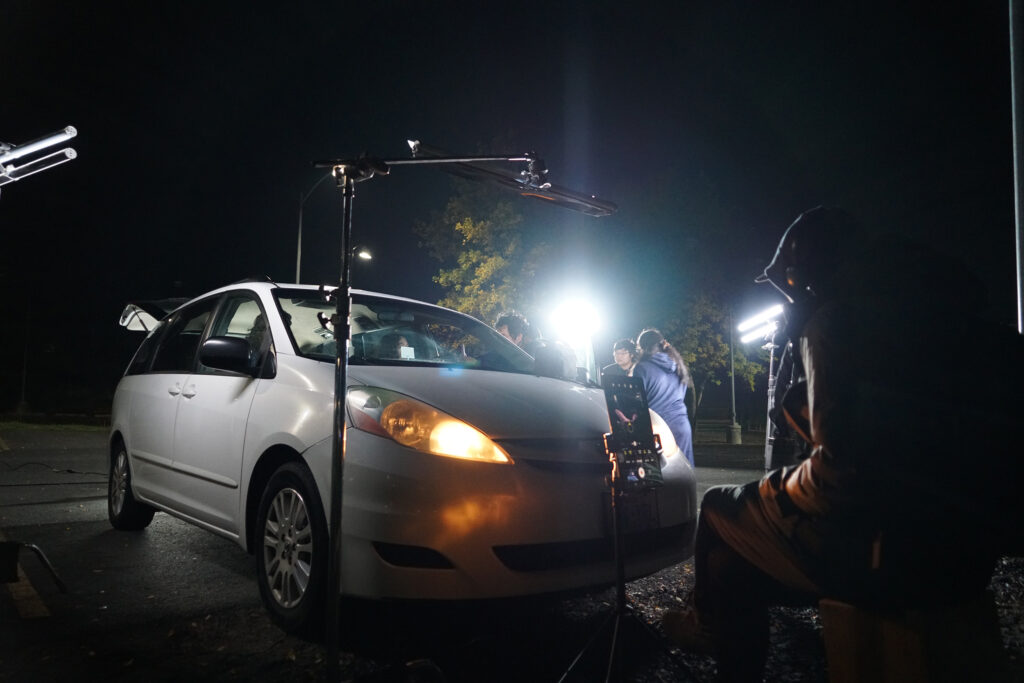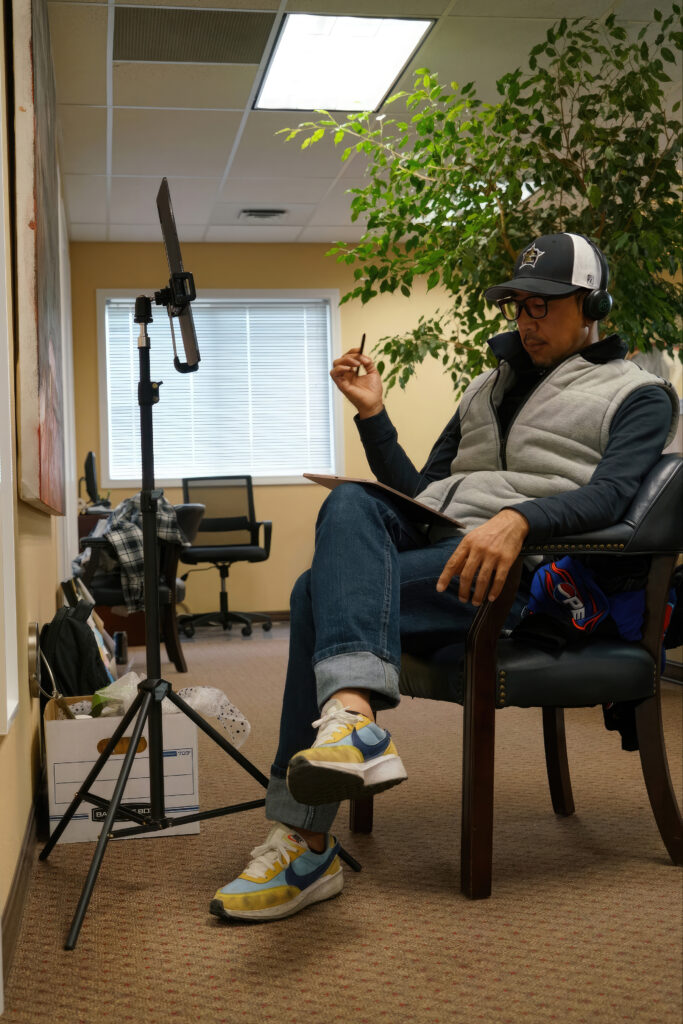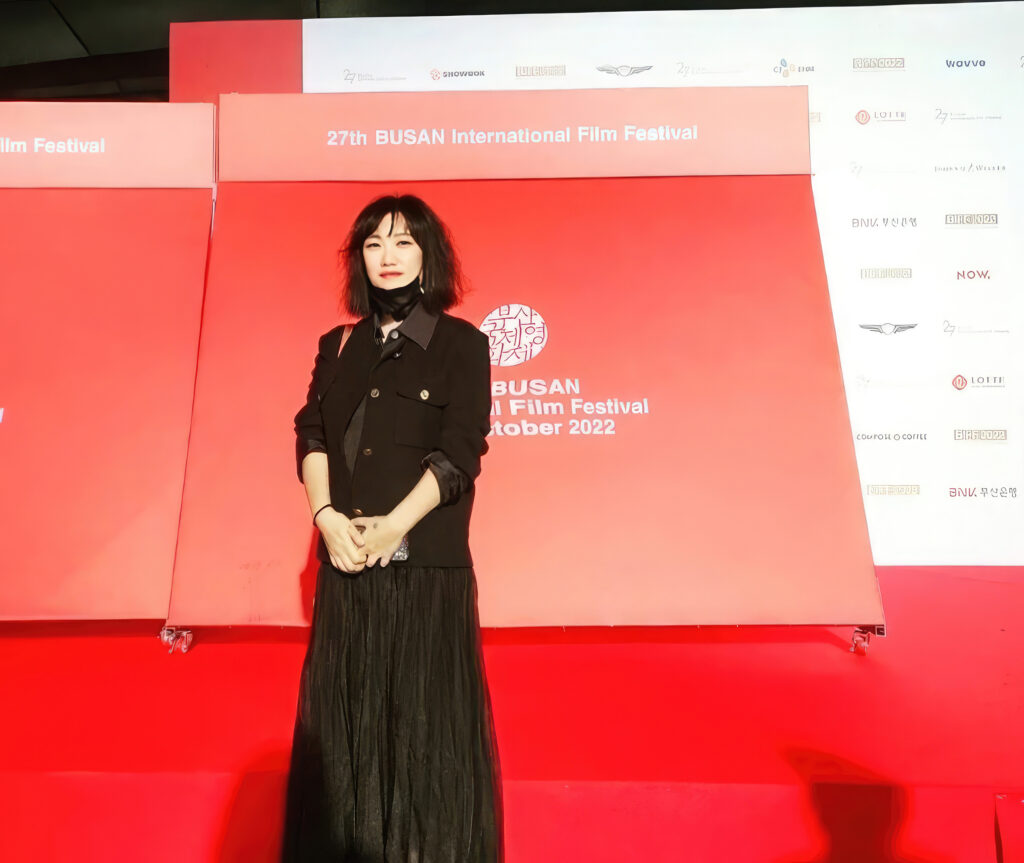
Today we have an exclusive interview with the creative minds behind the film “The Invitation”. Joining us are director Yonghee Lee and producer Minah Jung. “The Invitation” stands as the world’s first vertical feature film, offering a unique and immersive viewing experience. The film is a unique modern thriller tackling the harms of social media, and besides its artistic value it also pioneers innovative technologies. As we embark on this interview, we’ll explore the creative process, challenges, and triumphs that shaped “The Invitation”.
Minah, how did you first decide to produce “The Invitation”? Did you work with director Yongehee Lee before? How did your and Yongehee’s combined experiences shape the film’s production?
M) I crossed paths with director Yonghee Lee while working in Korea, though we hadn’t collaborated previously. With most of my experience in the USA and director Lee boasting over two decades of experience in Korea, we successfully merged our industry connections and knowledge to bring a singular project to life.
Yonghee, how did your experience working as a producer affect your career as a director?
Y) My many years of producing, overseeing budget came very handy. I skillfully determined which scenes demanded our utmost attention and how to allocate our budget most effectively. Additionally, we efficiently managed our time during the filming of bridge scenes.
“The Invitation” is a story about sexual harassment, falsified videos, revenge and secrets. What motivated you to explore these themes? What do you hope the audience takes away from the film?
Y) I’ve come to realize that people are becoming increasingly self-centered. The “It’s none of my business” and “This won’t be my problem” attitudes are often used to justify and fulfill personal desires, often at the expense of respecting others. With the easy accessibility of content on platforms like YouTube and TikTok, where content creation is often driven by financial incentives, people sometimes create content without considering the potential harm to others.
The characters in this film, while ordinary, share a similar lack of guilt regarding their actions and exhibit self-centered behaviors. My hope is that this film encourages the audience to take a moment to reflect on their own actions and consider the impact they may have on others.
M) I believe the themes in this project reflect our daily lives. We often watch violent content either to satisfy our own desires or to alleviate stress, but we rarely consider the perspective of those who are actually experiencing such violence. I hope that, as the audience engages with our characters, they can come to a realization and feel a sense of empathy, fostering a connection with the experiences depicted.

“The Invitation” is the world’s first vertical feature film. What inspired you to explore this unique vertical screen format for the movie?
Y) One night, I was driving and had a revelation – I could only see the road directly ahead where my headlights were illuminating, while all other sides were enveloped in pitch-black darkness. The sight was both captivating and eerie. The inability to see the peripheries brought a sense of unease, but it also served as a motivating force, much like racehorses galloping forward.
This experience, coupled with my observation of vertical content, sparked a desire to convey the emotions I felt during that nighttime drive. Although I don’t have many reference films, I distinctly recalled a short film titled ‘Stuntman’ directed by Damien Chazelle, which was sponsored by Apple in 2020.
M) Director Lee shared his experience of driving at night and inquired if there were feature films shot in 100% vertical format. My immediate response was “No,” and then I found this idea particularly intriguing, especially considering the impact of the vertical angle on the audience’s focus since there are no distractions in the background.
Given the scarcity of references due to the limited number of cinematic vertical contents, I began to envision scenes from other films being shot in a vertical format, such as the iconic mirror scene from ‘The Contact (1997).’
Yongehee, could you tell us more about the creative process and challenges of adapting a traditional cinematic experience to a vertical format? How did this format enhance the storytelling and visual aspects of the film?
Y) Once the script had been finalized, I embarked on drawing my own storyboard. It was at this point that I noticed a curious contradiction within myself – while my mind was envisioning everything in a vertical format, my hand was instinctively sketching in the conventional wide angles. This paradox led to more than a few chuckles on my part. After spending two decades working with standard wide frames, breaking the habit of perceiving everything vertically proved to be the most challenging aspect. Moreover, translating my imaginative concepts into unfamiliar angles presented its own set of difficulties.
Consequently, I made a conscious decision to emphasize the characters in our project. Since our story predominantly unfolds within the confines of a car, I directed characters seated in the back to engage in conversation facing forward. We positioned characters both in the front and back, creating a dynamic that allowed us to perceive their spaces from front to back, rather than just side to side. Additionally, we capitalized on the vertical dimension rather than focusing solely on the horizontal. This choice introduced a captivating visual element with the sky becoming an intriguing part of the composition.
Minah, “The Invitation” features an innovative wireless set, with the Samsung ‘Galaxy S23 Ultra’ as the primary camera. Can you explain the decision behind using this technology and how it streamlined the production process?
M) Our choice to use the Galaxy S23 as our primary camera had several budget-saving benefits. We eliminated the need for focus pullers and lens changes, resulting in substantial savings on both crew and equipment expenses. Additionally, we streamlined our on-set setup by monitoring the production through a Galaxy tablet mirror connected to our camera, eliminating the need for a separate monitor table. We also made efficient use of Astera lights with app control, reducing the time and labor required by the lighting departments.
The key motivation behind opting for a wireless set was to ensure that we could adhere to our production schedule, and I’m pleased to report that this approach was remarkably successful. Our set operated with exceptional time efficiency, contributing to the overall success of the project.
Minah, traditional film sets are often cluttered with cables and wires, which “The Invitation” successfully minimized. What benefits did this wireless set environment bring to the production in terms of safety and efficiency?
M) Our filming involved a diverse range of locations, from indoor parking lots to vast open wheat fields. Several of these locations might have posed challenges, as they had no access to network or electricity. However, thanks to our cable-free approach, we successfully completed all the footage on schedule, and our minimal set-up also ensured a safe shooting environment without any issues.
Yongehee, you have executive produced the Netflix feature film “Carter”. How did your prior experience as a producer influence your approach to directing “The Invitation”?
Y) ‘Carter’ is mostly filmed with one continuous shot. With that experience, I was able to director scenes with interesting one continuous scenes in our film.

Minah, “The Invitation” was filmed in various locations, including Washington State. Could you share how these locations influenced the film and how you collaborated with Samsung USA and Washington State University in the production process? How did you secure support from partners like Samsung USA and Washington State University?
M) I am filmmaker currently based in Washington State, and I was aware of the abundance of excellent locations for filming horror. Initially, our story was centered around nighttime settings. However, upon discovering environments in the region, such as an empty road by the riverside and an abandoned shed in the open, sunlit yellow wheat fields, we were captivated by the eerie and unique quality they offered, even in broad daylight. This discovery prompted Director Lee to revise the scenes, shifting the action to daytime settings and infusing our film with a distinctive and unconventional atmosphere.
Samsung also expressed enthusiasm for the idea of shooting an entire horror feature film in a vertical format. Although they had collaborated on short films using their devices, it was a novel approach, and they were keen to provide their support. Regarding Washington State University, our aim was to collaborate with students to provide them with real industry experience and experimentation.
Yongehee, as the director, how did you balance the challenges of working with a unique format, wireless technology, and storytelling to create a cohesive and engaging film?
Y) Being the first cinematic film shot in a vertical format presented numerous challenges. Directing both the crew and actors to adapt to this unique angle was no easy task. The absence of the usual side-to-side space in favor of an up-and-down orientation was a significant adjustment for everyone, and even minor movements could lead to bloopers. We closely focused on capturing the actors’ facial reactions for nature of vertical angle, which may have placed an additional burden on them.
However, the biggest challenge we faced is the lack of platforms for showcasing and distributing vertical films. While our status as the world’s first vertical feature film has piqued everyone’s interest, from a distributor’s perspective, there is hesitancy regarding profitability.
Yongehee, “The Invitation” is based on the Korean TV series ‘Urban Legends Season 1.’ What aspects of the original series did you aim to preserve, and what did you adapt to make it suitable for a feature film format? How did you decide on choosing the source material?
Y) My intention was to preserve the theme of how everyone’s selfishness led to the tragic death of an innocent woman and their subsequent retribution through death. As I developed this story into a feature-length film, I delved deeper into the backgrounds of each character and changed the setting to a car and a highway.
To harmonize the narrative with our vertical shooting concept, I introduced dynamics of power and weakness among the characters, placing them in various upward and downward angles. I used zoom techniques and directed them to match their eye levels with the respective angles.
The reason I chose this particular episode is that I wanted to underscore and raise awareness among the audience about how our seemingly straightforward cell phone-centered lives can significantly impact someone else’s life.
Can you give us a glimpse of your future projects or aspirations as a filmmaker? Are you also planning on exploring new filmmaking technologies in the future?
Y) My primary goal is to present this film at international film festivals, and I have a plan to create a feature film that predominantly unfolds within a bus. This project is an ambitious experiment involving the use of 20 cameras set up within the bus, allowing us to capture scenes in a single continuous take.
While I cannot predict what the future holds, I remain open to the possibility of returning to work on big-budget films. However, I also aspire to continue making low-budget films and explore various innovative approaches to storytelling with limited resources. My hope is that these endeavors will serve as an inspiration for fellow filmmakers, encouraging them to embark on their own creative journeys..
M) As a Korean-American filmmaker, I have a vision to bring compelling projects from Korea for collaboration in various regions of the USA. With the production of “The Invitation,” I’ve witnessed a growing interest within the Korean community to actively engage in filmmaking and share their narratives.
My plan is to immerse myself even more deeply in the Korean community, providing support to help them bring their stories to the screen. Additionally, I have a few scripts in development, and I am eager to explore diverse technologies and innovative methods to create distinctive and original films.
“The Invitation” pushes boundaries in terms of technology and storytelling. What kind of impact do you hope it will have on the film industry and future filmmakers?
Y) While it would be ideal to have a high-budget production with a top-tier Hollywood crew, the absence of such resources should not deter anyone from making films. It’s entirely possible to create excellent films with a limited budget, as long as the focus remains on telling compelling stories.
During the filming of ‘The Invitation,’ we managed to stretch our budget by using the Galaxy S23 Ultra as our camera, and the vertical format significantly reduced our art-related expenses. These cost-saving measures applied to everything from equipment to crew expenses.
It’s crucial to recognize that a large budget doesn’t always guarantee a good film, and conversely, low-budget productions can be truly remarkable. So, my advice to aspiring filmmakers is this: don’t hesitate. If you have a story to tell, please tell it. Talent and creativity can shine through even in the most budget-constrained circumstances.
M) I’m deeply honored to have been the producer of the world’s first vertical feature film, “The Invitation.” It has reinforced my belief that if you have a story inside you, it must find its way out into the world. Each of us lives in our unique cultural context, with distinct personalities, and an array of individual experiences, resulting in a treasure trove of untold stories waiting to be shared. There is an audience out there for every story, eager to listen and connect with the narratives we create.
I believe that everyone who played a role in the making of ‘The Invitation’ took a courageous step in coming together to tell this exceptional and unique story. It’s a testament to the power of collaboration and storytelling, transcending boundaries and inspiring others to share their tales with the world. Our film stands as proof that there are no limitations when it comes to storytelling, and it is an invitation to the world to continue embracing the boundless diversity of narratives that exists within all of us.

Could you share any memorable moments or challenges you encountered during the production of “The Invitation” that had a significant impact on the final product?
Y) We encountered a significant challenge when our main cast informed us of their withdrawal just one week before the shoot. We swiftly recast the role, but then faced another setback when the replacement actor dropped out a mere two days before filming. This abrupt change meant we could no longer use any of the prepared insert shots designed for the original cast.
This situation forced us to make rapid adjustments, including rescheduling, adapting wardrobe, and altering the set to accommodate the last-minute changes. Thankfully, we were able to secure a replacement actor at the very last minute, and remarkably, this new talent had the perfect image for the role, turning our initial misfortune into a blessing.
This experience reinforced the valuable lesson that it’s not truly over until the final curtain falls.
M) I recall a day when we were scheduled to film a thrilling car chase scene. Unfortunately, we encountered a significant obstacle – we didn’t have a suitable vehicle available to execute the director’s vision. Despite this setback, the shoot was not canceled.
Instead, the director gathered the entire cast and crew, and in that moment, I witnessed the incredible synergy of everyone coming together. Rather than being disheartened or giving up, there was a collective determination to find a creative solution. As I translated the director’s revised vision, it was inspiring to witness the collaborative spirit in action.
We adapted the scene, shifting the focus to our characters, and the actors demonstrated exceptional teamwork. This experience rekindled my appreciation for the beauty of filmmaking, where individuals with diverse talents unite to tell a unique and compelling story. It served as a reminder that, in filmmaking, creativity and resilience can overcome any obstacle.
Minah, as a producer, what are the key takeaways or lessons you’ve learned from your experience working on “The Invitation” that you can share with aspiring filmmakers or producers?
M) My journey with this film has been an invaluable learning experience. We navigated the complexities of coordinating a unique blend of crew and cast, with members hailing from different parts of the world and various states. This presented its fair share of challenges, but in the end, we all came together to bring this distinctive story to life.
One crucial lesson I’ve taken away from this endeavor is the importance of teamwork. Every person involved is a vital part of the team, and I’ve come to appreciate their contributions even more as a result of this film. Furthermore, the advancements in technology have made it possible for us to tell stories at any time, within our budget. What truly matters is your determination and passion. You don’t need extravagant budgets or high-end equipment to convey your narrative. Often, less is more, and the essence of storytelling lies in your dedication and creativity.
